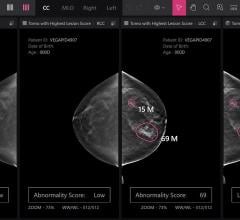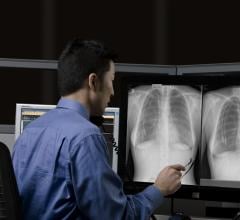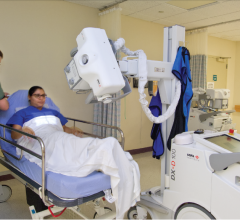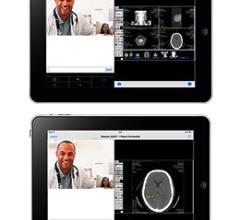May 22, 2014 — Viztek showcased its new Exa EHR (electronic health record) platform at the Society for Imaging Informatics in Medicine (SIIM) annual meeting in Long Beach, Calif. Viztek is delivering the first EHR that is embedded into PACS (picture archiving and communications system), enabling radiologists to share and exchange data as required by meaningful use.
Extending the "Evolution of Visual Healthcare" to mobile devices, Agfa HealthCare launched its new Web-enabled mobile image management technology that brings the power of ICIS to iPhones, iPads, Web and Android mobile digital devices.
At the 2014 SRS/SBRT Scientific Meeting in Minneapolis, Mirada Medical presented information on how its DIR algorithms and RTx software tools can improve the accuracy required in radiosurgery treatment planning.
Radiology departments have many different needs and face a wide variety of challenges that can impact their departments ...
May 21, 2014 — Siemens Healthcare announced that the U.S. Food and Drug Administration (FDA) cleared the Somatom Force computed tomography (CT) system — the next generation in dual source CT.
A study conducted at Massachusetts General Hospital and Harvard Medical School found that estimated radiation doses are substantially lower for pediatric computed tomography (CT) exams of the brain that used an adaptive statistical iterative reconstruction technique (ASIR) compared to those that did not use ASIR.
The FDA has recognized 3-D printing technology now exists to print medical devices and is gathering information regarding technical assessments that should be considered when it will inevitably begin reviewing these types of future FDA submissions.
Despite decades of progress in breast imaging, one challenge continues to test even the most skilled radiologists ...
Sony Electronics’ Medical Systems Division showcased a full line of medical grade monitors for radiology applications, including the LMD-DM50, LMD-DM30C and LMD-DM30 models, at the 2014 Society for Imaging Informatics in Medicine (SIIM) meeting, in Long Beach, Calif.
Three Palm Software announced the release of the 1.7.1 version of its breast imaging workstation — WorkstationOne.
May 20, 2014 — Siemens Healthcare announced the U.S. Food and Drug Administration (FDA) has cleared the 16- and 32-slice iterations of its Somatom Perspective computed tomography (CT) system.
Bayer Radiology’s Barbara Ruhland and Thom Kinst discuss how radiology departments can address the many different ...
May 20, 2014 — GE Healthcare and Tesla Engineering Ltd. are collaborating to produce 7T human whole-body magnetic resonance imaging (MRI) scanners. The companies made the announcement at the joint meeting of the International Society for Magnetic Resonance in Medicine (ISMRM) and the European Society for Magnetic Resonance in Medicine and Biology (ESMRMB) in Milan.
May 19, 2014 — GE Healthcare and CorTechs Labs announced the signing of a strategic joint-marketing agreement at the joint meeting of the International Society of Magnetic Resonance in Medicine (ISMRM) and the European Society of Magnetic Resonance in Medicine and Biology (ESMRMB), held in Milan. The companies will collaborate to co-market an MRI (magnetic resonance imaging) scanning solution combined with NeuroQuant, CorTechs Labs’ MRI post-processing application.
May 19, 2014 — NIA Magellan, a subsidiary of Magellan Health Services Inc., recently launched “RadZone Kids,” an easy-to-use community resource to assist parents and caregivers in preparing their children for various diagnostic imaging tests, including CT (computed tomography) scans, MRI (magnetic resonance imaging) scans and X-rays.
eHealth Saskatchewan plays a vital role in providing IT services to patients, health care providers, and partners such ...
According to a study presented at the 2014 ARRS Annual Meeting in San Diego, misinformation and misunderstanding about the risks associated with ionizing radiation create heightened public concern and fear, and may result in avoidance of screening mammography that can detect early cancers.
May 19, 2014 — A Japanese multi-institutional study1 of 1,194 patients, has found that individuals with five to 10 tumors treated with Gamma Knife stereotactic radiosurgery alone (no whole brain radiation therapy) fared as well as a group with two to four tumors who received this radiosurgery-only treatment.
Proton therapy is in the proverbial chicken or the egg scenario. Companies are pulling back on reimbursements to treat some cancers — notably prostate, breast and lung — because of the added expense and limited evidence to back it up.
May 16, 2014 — Lexmark’s Perceptive Software announced that its 2014 cycle of testing has been successfully completed.
May 16, 2014 — The Comprehensive Cancer Center of Wake Forest Baptist Medical Center is one of only a handful of cancer centers that is attempting to give lung cancer patients out of treatment options a chance to keep the cancer at bay. Two complementary papers published back-to-back recently in the journal Radiotherapy and Oncology and the Journal of Thoracic Oncology outline the treatment success at Wake Forest Baptist.
May 16, 2014 — Novarad Corp. is introducing and demonstrating NovaGlass at the 2014 annual meeting of the Society for Imaging Informatics in Medicine (SIIM) in Long Beach, Calif.
As the oldest and largest in-patient hospital within its area, Signature Healthcare Brockton Hospital in Brockton, Mass., serves a diverse community of needs. The hospital is home to a transitional residency program, and has a full imaging department. Twenty-one surrounding communities are also served by Signature Medical Group, the largest multi-specialty and multi-provider physician practise group in the area with 11 sites, including mirrored services in CT, MRI, ultrasound, radiology and mammography.
May 15, 2014 — Medweb announced the introduction of several new features for Medweb Collage that will further enable the sharing of information across healthcare systems and promote secure access to patient information from mobile devices. The EHR/EMR Gateway seamlessly integrates patient imaging and reports from Medweb Collage into any EMR (electronic medical record) via industry standards.

 May 22, 2014
May 22, 2014 













